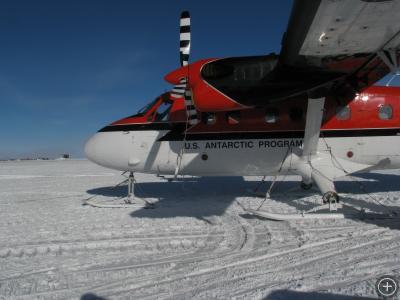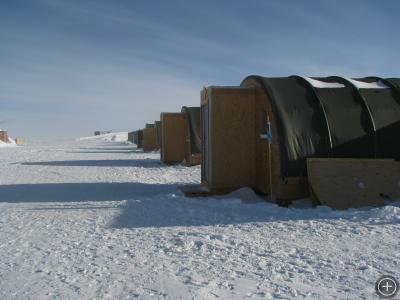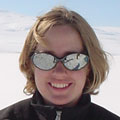The Recon Flight and Sastrugi Problem
Nov 13, 2008
Temperature -40 deg F
SOUTH POLE STATION, ANTARCTICA– Phase One of our traverse from South Pole Station to the Norwegian Antarctic base, Troll, is to recover the four tracked vehicles we are using, which are currently stranded 350 km from the South Pole. Svein, Kjetil and Rune are the cracker-jack mechanics who will fix two of the vehicles, which are currently non-operational, and replace the differentials (this being the part that broke several time last season) in all of the vehicles. Lou and I are going to drill an ice core while the mechanics do the repairs. The spot where we will be working is called Camp Winter, since that is where everything spent the last season.
Last week, a reconnaissance flight over the vehicles determined that the surface out there is too rough to land for the Basler aircraft we were scheduled to take on Saturday. This is because there has been more than one main wind direction, which results in sastrugi (wavelike ridges on the surface of hard snow) oriented in different directions, and a rough landing for any plane.
The Basler has two skis and is heavier compared to the Twin Otter’s three skis, lighter weight, and beefier suspension. The pilot on the recon flight had done a “ski drag,” touching the surface, but not landing, to determine how bad the surface really was there. He didn’t even want to land the Twin Otter near Camp Winter, but saw a smoother area a bit further away where he planned to land, and then taxi everyone over to the vehicles. The crew on the recon flight took pictures of the vehicles, so we think that, at least from the air, things look ok, and nothing major is missing or completely buried. As Einar happily pointed out there are no “little black spots scattered all over the snow.”
The plans were changed so that John, Kjetil, and Svein will fly out in a Twin Otter to set up Camp Winter with minimal gear on the first flight. Glen, Einar, and Rune will follow. The Twin Otter cannot carry as much cargo as the Basler, and so there will be 3 more Basler flights as soon as they can make a skiway (a snow runway) for the Basler. The South Pole has a clean air zone, which happens to lie directly in the path between the South Pole and our vehicles, and so the Twin Otter, an unpressurized plane, had to fly “over” the clean air zone, at an altitude of 30,000 ft. This means that the passengers have to fly with oxygen masks.
At Camp Winter, the plan is to open up the workshop module (all the doors have been screwed shut to prevent them from blowing off and to keep snow from blowing in) and start heating it right away using a generator for power. The next task is to get one of the vehicles running so that they can groom a skiway for the Basler aircraft to land on, bringing the rest of our cargo out to Camp Winter. Making the skiway flat enough for a plane to land on means that the group out at Camp Winter will have to knock down the same large sastrugi (snow dunes that form into the wind) that the pilot had a hard time landing on. Sastrugi tend to be very hard, as they are made from windpacked snow. The plan for now is to use the blade on Jack to knock over the tops of the sastrugi, then improvise some sort of grater using materials out at Camp Winter…2 x 4’s, the decking for the modules, or chain. In a few minutes, Lou, John, Rune, and Kjetil, who all have experience grooming skiways, were able to come up with several options using materials out at camp.
Just to set the scene for what these guys are doing…they are flying from the South Pole, already in the middle of nowhere, but at least the middle of nowhere with 240 other people, and a galley staff dishing out warm, hot meals, an extremely large, warm station, wireless internet access in our tents (our tents!) in Summer Camp, running water, telephones, a game room, a gymnasium and weight room, lounges and big screen TVs, a pool table, and 3 to 4 daily flights coming in to diminish the sense of isolation. They are leaving to go 350 km from here, to four vehicles that have been left on the ice sheet for the entire winter. We have the recon flight pictures showing that nothing has blown away, and that nothing is completely buried. But we don’t know if the seals on the doors have held, or if the windscreens on the vehicles have broken and everything is filled with snow. We don’t know if the vehicles will start or if the heaters on the modules will fire up.
John has considered all these scenarios, and we have multiple plans for the multitude of things that can happen. We are sending the first group in with medical supplies (including a Gomow bag, oxygen tank, and meds to deal with altitude sickness, the most likely major thing that would go wrong), several generators, fuel, emergency shelters, clothing, some water, and a minimal set of tools. That’s it!
The mood leading up to the flight is one of relaxed confidence that everything is going to work out just fine. I think this is part of the Norwegian character. All of our meetings and discussion have an element of humor (except the safety meeting we had in McMurdo…that was all business). Today, handing out the emergency communication devices to use in case of a plane crash–an Iridium phone, a PLB (personal location beacon) and radio–Kjetil jokingly gave Svein the PLB since it “only has one button to push.”

 No comments
No comments 











